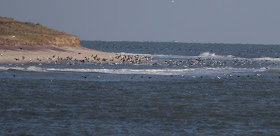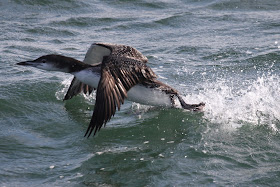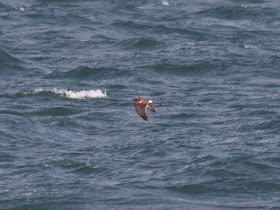Rounding the Southern Tip of Monomoy- As we crossed the southern tip of Monomoy, the numbers of sea ducks increased including the number of Oldsquaw....
.....White-winged Scoters.....
.....and so did the numbers of Grey Seals!-
Swimming Gannets were just about everywhere you looked-
But the numbers of sea ducks increased to thousands and thousands of them. Although impressive, it is only a fraction of what will be rafted there in a month. This area is legendary for the huge and massive numbers of wintering sea ducks which has been known to exceed well over half a million!
The Helen H had slowed it pace down a bit so everyone could enjoy the mass of sea ducks. Someone spotted a single adult Lesser Black-backed Gull on the beach and it was announced over the pa system. (Lesser Black-backed Gull all the way to the right)-
While we were looking at the Lesser Black-backed Gull, more passerines passed over the vessel. A Peregrine was sighted passing over the Island. Suddenly the mornings first surprise unfolded when a single unidentified Shorebird was spotted flying over the water. A very excited Steve Mirick announced over the pa that it was a Woodcock! (Photo courtesy Bill Thompson)-
The next winter Gull to make an appearance was an adult Iceland Gull that traded back and forth along the beach.-
The Helen H passed along the southern tip of Monomoy, and more sea ducks, Gannets, and Loons (mostly Common and a few Red-throated) were passing by. As we crossed by the eastern tip of the point, the mass of Sea Ducks took off from the water.-
White-winged Scoters-
Monomoy Lighthouse viewed from the east-
More flocks of Oldsquaw-
.....and a large raft of Common Eider-
Gannets passed by the bow....
.....with many swimming and taking off when we approached-
When we started moving towards the North to outside South Beach and Chatham inlet, the numbers of Gannets increased with several hundred feeding around the vessel. This area is where we started spotting the first Kittiwakes of the day-
There were also an increase in the numbers of Common Loons-
Bill and I spotted two small alcids on the water only twenty yards off the pulpit. We only had a quick look and before we could identify them; they dove. One bird surfaced briefly and dove again (or maybe it was a third bird just returning to the surface). I yelled "Alcid" and the vessel stopped. We all looked around, and Steve exclaimed that the Alcids had surfaced off the starboard side, but quickly dove again. We stayed for a few minutes but never re-located the birds. Bill and I discussed the birds, and we both thought they were Dovekie.
Part 3- Heading East- The sea was still relatively flat with small waves. The Captain turned the Helen H starboard and we headed in an easterly direction.
The Gannet numbers thinned a bit at that point, but they were always present nearby both in the air and on the sea-
The number of Kittiwake however, increased dramatically!-
As we moved east, and occasional Common Loon either flew by or swam by the vessel-
As we steamed East, the number of passerine sightings increased with Pine Siskins and Crossbills most commonly noted. Within twenty minutes of the easterly turn, the second unexpected and unusual sighting of the day appeared, when a Harrier crossed by to the port side of the Helen H.-
(Below image courtesy of Bill Thompson)-
Soon after, the first Shearwater of the day; a Manx passed by in the distance-
More Kittiwake, both flying and swimming on the sea. I really like Kittiwakes and it was very exciting to see and photograph so many of them (especially swimming) that day!-
Gannets always give everyone a wonderful viewing opportunity, often just over our heads!-
Adult Kittiwake-
Second winter Gannet-
First winter Kittiwake-
I like these shots of this backlit Gannet-
The first Greater Shearwater of the day passed by the port bow at seventy-five yards-
Standing on the pulpit, the appearance of the first Pomarine Jaeger of the day was exciting. The bird came from the distance and flew directly at us! Pomarine Jaegers are a true treasure of the sea!-
As the Jaeger passed by the bow, we all watched it disappear into the distance. What seemed like a minute later, I looked down to see an odd bird shape sitting on the sea in the distance. I was puzzled at first, I had seen this silhouette many times, I just couldn't place it on the ocean. As we got closer, the bird took off and now became the third unusual and most unexpected sighting of the day; a Coot?? A Coot, way out here!!?? First a Woodcock, than a Harrier, now a Coot, wonder what was next?!-
Part 4- Heading Southeast along the edge of Monomoy Shoals: through Pollock Rip, Orion Shoal to Great Round Shoal Channel: (just North of Nantucket Shoals)- In the distance the horizon was filled with birds and the Helen H changed course and sailed towards them. Although the bird numbers were good so far, this was the first large concentration (other than sea ducks) of sea birds that we spotted. The birds had obviously found a school of baitfish, and assuming most of the birds were Gannets and Kittiwakes, the possibility of other species in the area was high.
As we got closer to the swarm of sea birds, Kittiwakes surrounded the vessel-
And their numbers increased-
Not only were the birds flying, but there were plenty also sitting on the sea. This Pomarine Jaeger had apparantly forced this Kittiwake to give up its catch. It is now recovering the stolen prize of a Herring or other small baitfish-
A second Pomarine Jaeger swimming on the sea-
It lands again.......
.....only to take off once again. It passed right by the pulpit giving the all of us great looks!-
It joins the first Jaeger-
Kittiwakes were all around the boat. With the amount of baitfish and Kittiwakes in the area, more Pomarine Jaegers couldn't be too far away!-
To add to the baitfish schools, the mates started chumming off the stern. The concoction of ground up fish, fish oil and suet was quite enticing. The Kittiwakes were having a feast. They discovered the floating banquet when it had drifted a distance from the Helen H.-
Right on schedule....another Pomarine Jaeger; this one a dark morph,-
This is the second small group of Razorbills that morning. The other group that we spotted eventually dove away from the vessel as we got closer. We couldn't find them again. This group took off from the water and flew by the bow.-
Another group of Razorbills-
Mixed in with the Alcids was this single Greater Shearwater-
Part 5- Orion Shoal to Great Round Shoal Channel- On the last leg of the southeastern course to Great Round Shoal, we encountered many small groups of sitting birds. This group had Kittiwakes and a few Herring Gulls-
This group contained a handful of Gannets, and a Greater Sheawater (left).....
......and a Manx Shearwater (extreme left)......
Manx (left) and Greater (right) Shearwaters....
......and a small group of Razorbills popped up from a dive (rear right)-
Razorbills and Gannets-
Kittiwake-
As the vessel moved ahead, a Manx Shearwater took off and flew by the bow-
Another Kittiwake-
Another Manx Shearwater-
More Razorbills-
We also found another small group of Common Loons.....
.....and more Razorbills....
.....and a few more Greater Shearwaters-
But one of the highlights of the day for me was the two flocks of Kittiwakes sitting on the water. As we approached the birds, they took off; not from our approach, but from the Pomarine Jaeger that charged into the group sending them all air born!-
A Greater Shearwater crosses by the bow-
A second Pomarine Jaeger enters the Kittiwake chase!-
Another Greater Shearwater-
A third Pomarine Jaeger arrives going after the second group of Kittiwakes......
......and the chase is on!-
The pirate selects its victim.....
.....and it moves in closer......
....it has selected this adult Kittiwake.....
.....and is wingtip to wingtip! Both birds flew by the boat. Unfortunately, the pirate never succeeded in forcing the Kittiwake to give up its meal. The Jaeger went one way, and the KIttiwake went another way! The three Jaegers and two groups of Kittiwake made for a very memorable experience!-
More Greater Shearwaters-
Part 6- Great Round Shoal Channel- "Looking for Whales" continues......
.........click on "Older Posts" below right-















































































































































































